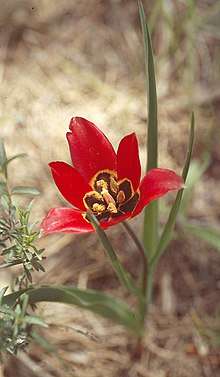Tulipa armena
Tulipa armena, the Armenian tulip, is an Asian species of tulip native to the historical Armenian Highlands as the name implies; current regions of Armenia, modern day Turkey, Iran, and South Caucasus.[2]
| Tulipa armena | |
|---|---|
 | |
| Scientific classification | |
| Kingdom: | Plantae |
| Clade: | Tracheophytes |
| Clade: | Angiosperms |
| Clade: | Monocots |
| Order: | Liliales |
| Family: | Liliaceae |
| Genus: | Tulipa |
| Subgenus: | Tulipa subg. Tulipa |
| Species: | T. armena |
| Binomial name | |
| Tulipa armena | |
| Synonyms[2] | |
|
Synonymy
| |
Description
Tulipa armena is extremely variable.[3] The bulb has a papery tunic that is not very hairy. The stems are between eight and 25 cm long, the 3–6 leaves are broad, scimitar-shaped, hairy or smooth and often have wavy edges. They are grey-green, but with a red overlay.[4] They can be up to 20 cm long. The large solitary flowers are cup- or bowl-shaped and very variable. Some are red with a dark violet, black or dark green basal blotch, sometimes striped and mottled in yellow, others yellow,[5] in the red form, sometimes the black basal blotch has a yellow border. The tepals are normally oval. The filaments are black or blackish purple, the anthers yellow or black.
Tulipa armena is placed in the subgenus Tulipa.[6] In Turkey, the subspecies lycica and armena are differentiated by the hairs on the bulb.
Tulipa armena is easily confused with Tulipa julia, which has a hairier tunic.[7]
Habitat
The Armenian tulip was found from Northeast Turkey through Transcaucasia (Armenia, Azerbaijan and Georgia) to northwestern Iran.[2] It grows on rocky mountain slopes between 1000- 2700m ASL and flowers between April and June.[4] It also occurs on the Marmaris peninsula in Southwestern Turkey at much lower elevations,[4] where it may have been introduced as an ornamental plant in Ottoman times.
Due to threats to the species via habitat loss and degradation caused by logging, overgrazing, road construction and human disturbance related to ecotourism. It has been only found in a single location in NE Anatolia, Turkey.[1]
It grows in steppe areas on alkalic soils with a high humus-content.[8]
Synonyms
Tulipa armena was first described by Edmund Boissier in 1859, the locus typicus is located in Northeast Turkey. Populations found in the Karabakh mountain range in Armenia and Azerbaijan have been called T. karabachensis, but this is regarded as a synonym of T. armena.[2][6] Plants from Eastern Turkey and Northwest Iran with a hairy tunic and longer stems have been described as T. willmottiae Freyn.[9] T. mucronata Fomin, T. karabachensis Grossh. pro parte, T. confusa Gabrielian may also be synonyms of T. armena.[10] The name T. galatica has been used for the yellow variety without basal blotch.[11] In contrast, Tulipa gumusanica has been confirmed as a separate species.[8]
Uses
The Armenian tulip is used as a garden plant. It needs dry, hot summers and should be grown in free draining soil and full sun. In England, it flowers in April.[12]
References
- Terzioğlu, S.; Coşkunçelebi, K.; Ayaz, S. (2014). "Tulipa gumusanica". IUCN Red List of Threatened Species. The IUCN Red List of Threatened Species 2014. 2014. doi:10.2305/IUCN.UK.2014-1.RLTS.T200587A2671389.en.
- "Tulipa armena", World Checklist of Selected Plant Families, Royal Botanic Gardens, Kew, retrieved 2013-10-15
- Anna Pavord, The Tulip (London, Bloomsbury 1999) 22f
- Anna Pavord, The Tulip (London, Bloomsbury 1999) 289
- W. Marais, Notes on Tulipa (Liliaceae). Kew Bulletin 35/2, 1980, 257 f. Stable URL: https://www.jstor.org/stable/4114569
- Christenhusz, Maarten J.M.; Govaerts, Rafaël; David, John C.; Hall, Tony; Borland, Katherine; Roberts, Penelope S.; Tuomisto, Anne; Buerki, Sven; Chase, Mark W. & Fay, Michael F. (2013), "Tiptoe through the tulips – cultural history, molecular phylogenetics and classification of Tulipa (Liliaceae)", Botanical Journal of the Linnean Society, 172 (3): 280–328, doi:10.1111/boj.12061
- Anna Pavord, The Tulip (London, Bloomsbury 1999) 23
- Kamil Coşkunçelebi, Salih Terzioğlu, Zafer Türkmen, Serdal Makbul, Ayhan Usta 2008, A comparative study on two closely relative Tulipa L. taxa from NE Anatolia. Plant Systematics and Evolution 276/3-4, 191–198
- W. Marais, Notes on Tulipa (Liliaceae). Kew Bulletin 35/2, 1980, 257. Stable URL: https://www.jstor.org/stable/4114569
- W. Marais, Notes on Tulipa (Liliaceae). Kew Bulletin 35/2, 1980, 258. Stable URL: https://www.jstor.org/stable/4114569
- Richard Wilford, Tulips, Species and hybrids for the gardener (Portland, Timber Press 2006), 80
- Richard Wilford, Tulips, Species and hybrids for the gardener (Portland, Timber Press 2006), 81
